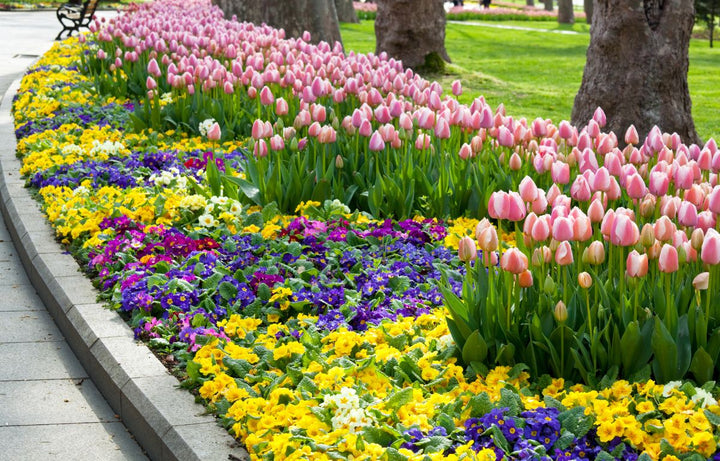
Top Spring Flowers
Top Spring Flowers
Spring is a time of renewal and colour, and nothing marks the season better than vibrant blooms in the garden. Spring-flowering plants bring life to outdoor spaces and brighten up homes, but choosing the right plants and providing proper care are essential for enjoying their full beauty. In this blog, we’ll explore some popular spring flowering plants, how to care for them, and solutions to common problems you might face.
Popular Spring Flowering Plants
-
Tulips (Tulipa spp.)

Tulips are iconic spring flowers that come in a wide range of colours and forms. They are easy to grow and make a bold statement in beds, borders, and containers.
Care & Maintenance:
- Planting: Plant tulip bulbs in autumn, about 15 cm deep in well-draining soil.
- Sunlight: Full sun (at least 6 hours a day).
- Watering: Water when planting and during dry spells.
- Fertilising: Apply a balanced fertiliser when leaves emerge.
Common Problems:
- Weak blooms: Ensure bulbs are planted deep enough and avoid overwatering.
- Tulip fire (Botrytis blight): Remove infected plants and avoid wet foliage.
-
Daffodils (Narcissus spp.)

Daffodils are bright and cheerful, often heralding the first sign of spring. They come in shades of yellow, white, and orange.
Care & Maintenance:
- Planting: Plant bulbs in the autumn, 7.5–15 cm deep.
- Sunlight: Full sun to partial shade.
- Watering: Water during dry periods in the spring.
- Fertilising: Feed with a low-nitrogen fertiliser after blooming.
Common Problems:
- Blind bulbs (no flowers): Divide crowded clumps and ensure bulbs are planted at the correct depth.
- Bulb rot: Plant in well-draining soil and avoid overwatering.
-
Crocuses (Crocus spp.)

These low-growing beauties are among the earliest to bloom, often poking through the snow.
Care & Maintenance:
- Planting: Plant bulbs in autumn, 7.5–10 cm deep.
- Sunlight: Full sun to partial shade.
- Watering: Water after planting and during dry spells.
- Fertilising: Fertilise lightly in early spring.
Common Problems:
- Squirrels digging up bulbs: Use bulb cages or cover with chicken wire.
- Poor flowering: Ensure proper sunlight and avoid overfertilisation.
-
Hyacinths (Hyacinthus orientalis)

Known for their rich fragrance and striking colours, hyacinths make a great addition to spring gardens.
Care & Maintenance:
- Planting: Plant bulbs in autumn, 10–15 cm deep.
- Sunlight: Full sun to partial shade.
- Watering: Water deeply when planting and during dry periods.
- Fertilising: Use bulb fertiliser when planting and after flowering.
Common Problems:
- Flower stalks flopping over: Plant bulbs deeper and ensure they receive enough sunlight.
- Yellow leaves: Avoid overwatering and plant in well-draining soil.
-
Primroses (Primula spp.)

Primroses offer early bursts of colour with shades ranging from yellow to purple. They are perfect for shaded spots and containers.
Care & Maintenance:
- Planting: Plant in early spring or autumn.
- Sunlight: Partial shade.
- Watering: Keep soil evenly moist, but not soggy.
- Fertilising: Use a balanced fertiliser during the growing season.
Common Problems:
- Powdery mildew: Ensure good air circulation and remove affected leaves.
- Crown rot: Avoid planting in waterlogged soil.
-
Peonies (Paeonia spp.)

Peonies are classic perennials that boast large, fragrant blooms in late spring, making them a must-have for spring gardens.
Care & Maintenance:
- Planting: Plant in autumn or early spring, with the eyes (buds) 2.5–5 cm below the surface.
- Sunlight: Full sun.
- Watering: Water regularly but avoid overwatering.
- Fertilising: Apply a slow-release fertiliser in spring.
Common Problems:
- Ants on buds: Ants are harmless and attracted to the nectar. No need to control.
- Powdery mildew: Provide good air circulation and avoid wetting foliage.
General Spring Flower Care Tips
Mulching: Use a layer of mulch around plants to retain moisture and suppress weeds.
Deadheading: Remove spent flowers to encourage more blooms and prevent disease.
Pest Control: Watch out for common pests like aphids and slugs, and use natural or chemical controls as necessary.
Soil Preparation: Ensure soil is well-draining and amend with organic matter for best results.
Spring flowering plants can transform any garden with a splash of colour, but proper care is key to keeping them vibrant. By choosing the right plants for your conditions, following maintenance guidelines, and addressing common issues, you can enjoy a thriving, beautiful garden each spring.
